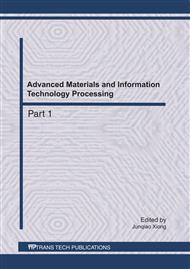[1]
G. Wittmann, J. Jakubik, and R. Ahl, Multiplication and distribution of Aujeszky's disease (pseudorabies) virus in vaccinated and non-vaccinated pigs after intranasal infection, Archives of Virology, Vol. 66(1980), pp.227-240.
DOI: 10.1007/bf01314736
Google Scholar
[2]
M. Pensaert and J. Kluge, Pseudorabies virus (Aujeszky's disease), Virus Infections of Porcines, pp.39-64(1989).
Google Scholar
[3]
J. Moynagh, Aujeszky's disease and the European Community, Veterinary microbiology, Vol. 55(1997), pp.159-166.
Google Scholar
[4]
T. Fujita, Aujeszky's disease control program in Japan, pp.85-96(1994).
Google Scholar
[5]
B. Klupp, W. Fuchs, E. Weiland, and T. Mettenleiter, Pseudorabies virus glycoprotein L is necessary for virus infectivity but dispensable for virion localization of glycoprotein H, Journal of virology, Vol(1997). 71, p.7687.
DOI: 10.1128/jvi.71.10.7687-7695.1997
Google Scholar
[6]
Lisa E. Pomeranz, Ashley E. Reynolds, and Christoph J. Hengartner, Molecular Biology of Pseudorabies Virus: Impact on Neurovirology and Veterinary Medicine, Microbiology and Molecular Biology Reviews, Sept. pp.462-500(2005).
DOI: 10.1128/mmbr.69.3.462-500.2005
Google Scholar
[7]
L. Pomeranz, A. Reynolds, and C. Hengartner, Molecular biology of pseudorabies virus: impact on neurovirology and veterinary medicine, Microbiology and Molecular Biology Reviews, Vol. 69(2005), p.462.
DOI: 10.1128/mmbr.69.3.462-500.2005
Google Scholar
[8]
P. Wu, W. M. Reed, and L. F. Lee. Glycoproteins H and L of Marek's disease virus form a heterooligomer essential for translocation and cell surface expression. Archives of virology Vol. 146(2001), pp.983-992.
DOI: 10.1007/s007050170130
Google Scholar
[9]
Babic N. , Klupp B. G., Makoschey B, Karger A., Flamand A. and Mettenleiter T. C. Glycoprotein gH of PRV is Essential for Penetration and Propagation in Cell Culture and in the Nervous System of Mice . J Gen V irol , 77(1996), pp.2277-2285.
DOI: 10.1099/0022-1317-77-9-2277
Google Scholar
[10]
B. Rost, and C. Sander, Prediction of protein secondary structure at better than 70% accuracy, J Mol Biol, Academic Press, England, Vol. 232(1993), pp.584-599.
DOI: 10.1006/jmbi.1993.1413
Google Scholar
[11]
K. Arnold, L. Bordoli, J. Kopp, and Schwede T. The SWISS-MODEL Workspace: A web-based environment for protein structure homology modelling, Bioinformatics, Oxford University Press , England, Vol. 22(2006), pp.195-201.
DOI: 10.1093/bioinformatics/bti770
Google Scholar
[12]
YAN Qi-gui, LEI Yan, ZHANG Zhi-he, WANG Cheng-dong, YANG Ai-guo, WANG Xu, ZUO Lan, XIAO Yang. Gene cloning and Bioinformatics Analysis of Outer Capsid Protein VP7 gene for Giant Panda Rotavirus CH-1 Strain. Acta Veterinaria et Zootechnica Sinica, Vol. 41(2010).
DOI: 10.5897/ajb11.1173
Google Scholar
[13]
Tatiana Gianni, Arianna Cerretani, Rebecca DuBois, Stefano Salvioli, Scott S. Blystone, Felix Rey, and Gabriella Campadelli-Fiume. Herpes Simplex Virus Glycoproteins H/L Bind to Cells Independently of αVβ3 Integrin and Inhibit Virus Entry, and Their Constitutive Expression Restricts Infection. Journal of Virology Vol. 84(2010).
DOI: 10.1128/jvi.02502-09
Google Scholar
[14]
Huixin Li, Shengwang Liu and Xianggang Kong. Charaterization of the gene encoding UL24, TK and gH proteins from duck enteritis virus (DEV) : a proof for the classification of DEV. Biomedical and Life Sciences, Vol. 33(2006), pp.221-227.
DOI: 10.1007/s11262-005-0060-6
Google Scholar
[15]
Charles Grose, John E. Carpenter, Wallen Jackson and Karen M. Duus. Overview of Varicella-Zoster Virus Glycoproteins gC, gH and gL. Current Topics in Microbiology and Immunology Vol. 342(2010), pp.113-128.
DOI: 10.1007/82_2009_4
Google Scholar


